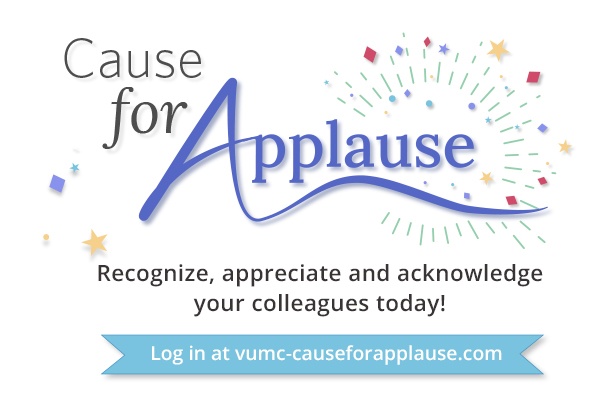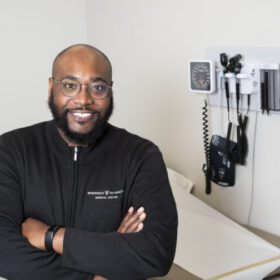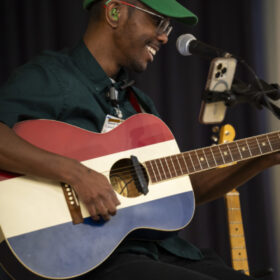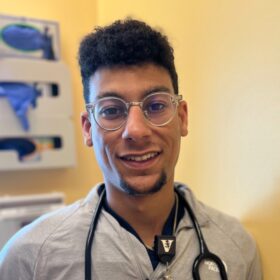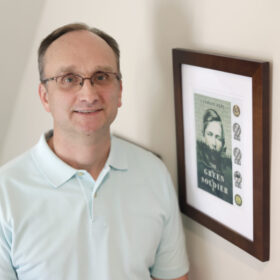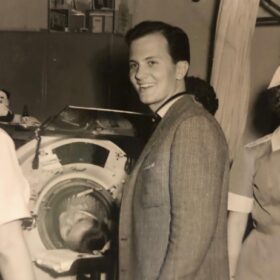Irish step dancing and science share equal billing in Maureen Gannon’s world
She is known for her diabetes research. She’s also pretty proud of her polished lift, a high, straight-legged kick that shows both flexibility and gracefulness.
June 26, 2023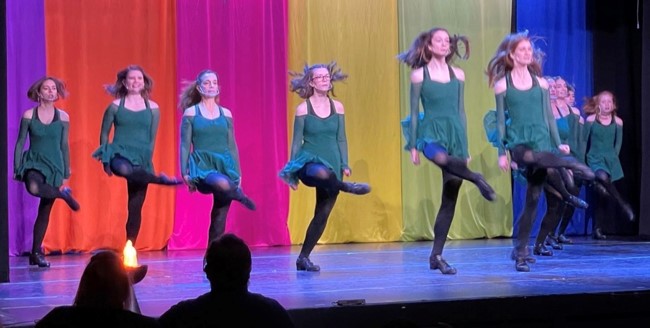
Gannon (third from left) performs with a step dancing group in 2021.
Maureen Gannon, PhD, professor of Medicine, Cell and Developmental Biology, and Molecular Physiology and Biophysics, admits to occasionally startling visitors to MRB-IV, the building housing her research lab on Vanderbilt University Medical Center’s campus.
As the elevator ticks up and down floors, she takes advantage of those captive moments to do “calf buster” exercises, rising up on toe-tip repeatedly with her feet stationed in various dance positions. She’s also been caught practicing actual dance steps as the doors slide open.
“I’ve stopped really quick, and I’m out of breath because I was dancing,” she said. “If there are hidden security cameras, somebody’s probably laughing at me somewhere. That’s OK. I don’t mind!”
On July 4, Gannon will strap on her hard shoes to compete in the North American Irish Dance Championships (NAIDC), aka “Nationals.” The annual NAIDC is one of the premier Irish dance competitions worldwide. This year it’s being held at Gaylord Opryland Resort and Convention Center in Nashville and is a qualifier for the prestigious World Irish Dance Championships.
Gannon is half Irish, half Italian and grew up in Queens, New York, where her family lived on a close-knit block filled with many first- and second-generation immigrant families.
It will be the first time in her decades of competing and performing that Gannon will dance alone in the soloist competition at the NAIDC, although she has competed as a soloist at many feiseanna (traditional Gaelic arts and culture festivals) and in the Southeast Regional Orieachtas. Gannon competed at NAIDC in the early 2000s in Boston as a member of an eight-person dance team with other members of the Nashville Irish Step Dancers (directed by Mary Moran, TCRG). They placed third at the event.
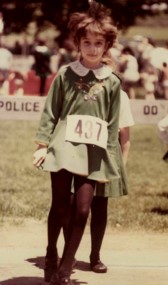
Gannon, age 8, in a dancing competition in her native New York.
Gannon is half Irish, half Italian and grew up in Queens, New York, where her family lived on a close-knit block filled with many first- and second-generation immigrant families. Gannon fell in love with the joyous, yet regimented tradition of Irish dancing thanks to the O’Sullivan family who lived down the street.
“Both parents were from Ireland, and they started an Irish dancing school at the Catholic elementary school we attended,” she said. “The teacher, Mr. Flynn, played the fiddle, so we danced to live music. Mrs. O’Sullivan was the assistant, and she would go around and correct the dancers. She’d put our feet in the right position and pinch us if we didn’t have good posture.”
Gannon danced from age 7 until 9, when the dance school was shuttered. Her friends and her sister Patti moved on to other interests, but Gannon felt an intense loss.
“There were lots of Irish dancing schools in New York, but my mom didn’t drive, and my dad was working. There was no way to get to another school. So, I just stopped.”
Years later, Gannon lived in Manhattan while earning her doctorate in cell biology and anatomy from Cornell University Medical College. The sights and sounds of New York City’s annual St. Patrick’s Day parade gave her feelings of bittersweet nostalgia.
“The bagpipers would come down Fifth Avenue, and I used to dance on the street corner to the music,” Gannon said. “I never forgot the steps, but that was that.”
At the time, adults didn’t typically take Irish dancing classes, and they certainly didn’t compete, so Gannon believed her days as an Irish step dancer were over.
Gannon came to Nashville in 1996 for postdoctoral training in the Vanderbilt laboratory of Chris Wright, DPhil. She studied genes that regulate embryonic pancreas development and expression of the insulin gene. She was busy, but a bit homesick. While Western line dancing at the Wildhorse Saloon was fun, it didn’t hold a candle to Irish step dancing for Gannon. She thought she had no hopes of reconnecting with the dance form in the Southern town that felt a world apart from New York and her Irish roots.
“Other than my husband and my son, I don’t have any other family here. Having that Irish dance community and the Nashville Irish Step Dancers is really like having a family and a supportive community”
She was wrong. Shortly after she moved to the South, Gannon attended a local event, the Celebration of Cultures (now the Celebrate Nashville Cultural Festival held at Centennial Park). She was excited to see dancers from the Nashville Irish Step Dancers school performing their intricate steps, and she was surprised to see adults on stage.
“I went up to the teacher, Mary Moran, afterward and told her I used to do that as a kid,” Gannon said. “She said, ‘Can you show me some steps?’ And I did.”
Ever since, Gannon has been taking weekly lessons with the Nashville Irish Step Dancers led by Moran, a certified Irish Dance instructor with the governing body, the Irish Dancing Commission. Unlike many schools which group dancers by age, Gannon, who is 58, learns alongside dancers of all ages performing at her skill level, which she much prefers.
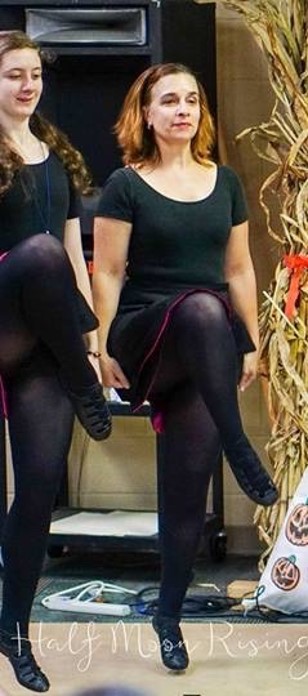
At a Fall Festival in Nashville in 2016.
“I actually think it motivates me more to dance with the kids,” she said. “And they’re so sweet. When I finally get a step that I’ve been working on, they’re screaming and cheering, ‘Oh, Miss Maureen, you did it!’ I think it helps keep me young.”
Mrs. O’Sullivan’s dreaded pinches have paid off as Gannon’s dance posture is immaculate. She’s also pretty proud of her polished lift, a high, straight-legged kick that shows both flexibility and gracefulness. She’s not so keen on her “turnout” skills. “Turnout” is maintaining an outward rotation of the leg from the hip to the toe, throughout the dance.
As her dancing progressed, Gannon’s reputation in the scientific world also grew. She became a Vanderbilt faculty member in 2001 and is now internationally recognized for her research. Her laboratory focuses on the function and regeneration of insulin-producing beta cells, with implications for Type 1, Type 2 and gestational diabetes.
“Part of the reason I started dancing again was to meet people who weren’t in science; I wanted to make some friends outside of work,” she said. “Other than my husband and my son, I don’t have any other family here. Having that Irish dance community and the Nashville Irish Step Dancers is really like having a family and a supportive community. I try to imagine someday somebody asking me, ‘So, do you still dance?’ and me saying, ‘No.’ I just can’t even imagine that.”
A highlight of her Irish step dancing career happened when she was few months pregnant with her son Erik. The Nashville Irish Step Dancers went to the Southern Region Oireachtas, and Gannon’s four hand (four dancers together on stage), eight hand (eight dancers) and choreography (sixteen dancers) all won first place.
“It was a super exciting time in my life,” she smiled. “I was a faculty member here, I already had my lab, I was pregnant, and I won first place as part of a team in all of those competitions.”
If you take an elevator in MRB-IV at the Medical Center, you might just catch Gannon practicing turnouts for the upcoming NAIDC as she hopes to add that final feather in her cap, competing as a soloist at the Nationals. If you want to see her dance, she’s performing at 2 p.m. on July 4 on the Delta B Ballroom stage at Gaylord Opryland Resort and Convention Center in Nashville.
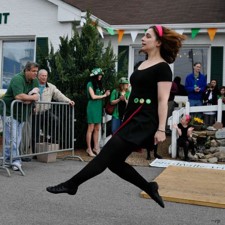
St. Patrick’s Day, 2013.
More about Irish step dance
Irish step dance has roots in traditional Irish dance dating from the mid-1800s. By the turn of the twentieth century, a growing Irish diaspora spread this dance style throughout the world, most significantly in larger cities such as Boston and New York City.
It’s characterized by an erect posture with a rigid upper body, arms immobile and straight beside the body, with hands in fists. The footwork is precise and rapid, performed mainly on the ball of the foot but punctuated with percussive strikes against the floor.
Dances are built from the same basic elements, or steps, but the combination of steps is unique. It is analogous to making different words using the same letters of the alphabet. Each step is a sequence of foot and leg movements and leaps lasting for 16 bars of music. It’s traditional to perform eight counts with the right foot leading, and to repeat in mirror image with the left foot leading. In competition, dancers must perform two steps or 32 bars of music.
There are six skill levels: beginner, advanced beginner, novice, prize winner, preliminary champion and open champion. Until recently, adults could only advance to the fourth level (Gannon is at this prize winner level), but now they can advance all the way to the top.
Some dances (reels, jigs, slip jigs, and single jigs) are performed in soft shoes (called a ghillie, pronounced with a hard “g”) and some are performed in a hard shoes (treble jib, hornpipe, and treble reel).
A step dance competition is called a feis (pronounced fesh), and dancers can only complete in a feis if their instructor is certified by the governing body, the Irish Dancing Commission. Each region in the world of Irish step dancing has an annual regional competition called the Oireachtas (pronounced or-rock-tis).




